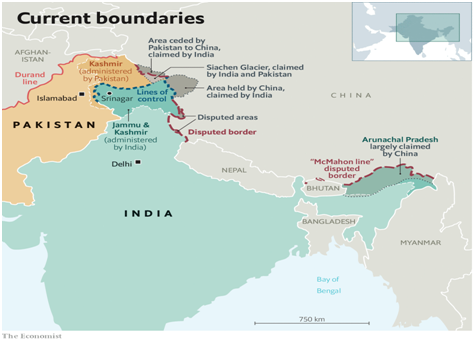

|
India’s Nehruvian foreign policy had five principal elements: 1) non-alignment with the two Cold War superpowers 2) the tendency toward moralpolitik inherited from India’s independence movement 3) the pursuit of Indian leadership among newly independent countries in the so-called Third World 4) the preference for cooperation over competition; 5) the de-emphasis of security and military power, for ideational and pragmatic reasons |
Context
October 20, 2022, marked the 60th anniversary of a key event in modern Indian history, the 1962 border war with China.
Background
- The brief war, in which Beijing defeated Delhi, represents an often-underappreciated watershed in Delhi’s foreign and security policies.
- 1962 marked the end of the Nehruvian era in Indian foreign policy and led to the emergence of a decisively more muscular and more realist India on the international stage.
- Even more importantly, the 1962 war inaugurated long-term changes in Delhi’s approach to international relations, which continue to shape Indian foreign policy to this day.
About
The course of War:
- Main cause of the war: a disputed Himalayan border, 1959 Tibetan uprising, when India granted asylum to the Dalai Lama.
- India initiated a defensive Forward Policyfrom 1960 to hinder Chinese military patrols and logistics, in which it placed outposts along the border, including several north of the McMahon Line, the eastern portion of the Line of Actual Control proclaimed by Chinese Premier Zhou Enlai in 1959.
- Chinese military action grew increasingly aggressive after India rejected proposed Chinese diplomatic settlements throughout 1960–1962, with China re-commencing previously-banned "forward patrols" in Ladakh from 30 April 1962.
|
The McMahon Line:
|
- Chinese troops pushed back Indian forces in both theatres, capturing Rezang Lain Chushul in the western theatre, as well as Tawang in the eastern theatre.
- The war ended when China declared a ceasefireon 20 November 1962, and simultaneously announced its withdrawal to its claimed "Line of Actual Control".

India-China (Territorial Disputes):
- China and India shared a long border, sectioned into three stretches by Nepal, Sikkim(then an Indian protectorate), and Bhutan, which follows the Himalayas between Burma and what was then West Pakistan.
- A number of disputed regions lie along this border. For ease of understanding, the India-China border can be divided into three areas - western sector, middle sector, and eastern sector.
|
Important Facts
|
-
- Western Sector:This sector comprises the area between Ladakh to Tibet and the Kunlun mountain range and also extends from Wakhan (Afghanistan edge) to the Karakoram Pass, thereafter following the alignment of the Kunlun mountain range.
- Middle Sector: This comprises the states of Himachal Pradesh and Uttarakhand. This is the least disputed sector and covers 545 km of Indian borders. Except for the larger claim of China in the Barahoti sector in Uttarakhand, other claims and counterclaims are miniscule.
- Eastern Sector:The eastern sector conventionally refers to Sikkim and Arunachal Pradesh, but both these states have Bhutan separating them.
How the war changed India?
Beyond ending the Nehruvian period, the war prompted three major long-term transformations in India’s foreign and security policy that shape it to this day.
- Strong defence: The war led Delhi to focus on its military and thus inaugurated the rise of India as a major military power. After the war India’s defense spendingrose massively.
- Realpolitik direction: Second, the 1962 war produced a long-term shift toward greater realpolitikin Indian foreign policy.
- Marking threat: It led Delhi to permanently redefine China as a potential security threat and thus change its understanding of its own security environment.
- Even after Beijing and Delhi relaunched their relationship in 1988 and signed major defense agreementsin 1993 and 1996, India continued to identify China as a major, potential security threat.

